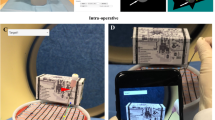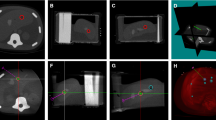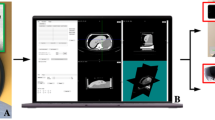Abstract
Objective
This study is to determine whether a needle guidance device combining a 3D-printed component with a smartphone would decrease the number of passes and time required to perform a standard CT-guided needle procedure in a phantom study.
Materials and methods
A 3D-printed mechanical guide with built-in apertures for various needle sizes was designed and printed. It was mounted on a smartphone and used to direct commercially available spring-loaded biopsy devices. A smartphone software application was developed to use the phone’s sensors to provide the real-time location of a lesion in space, based on parameters derived from preprocedural CT images. The physical linkage of the guide, smartphone, and needle allowed the operator to manipulate the assembly as a single unit, with real-time graphical representation of the lesion shown on the smartphone display. Two radiology trainees and 3 staff radiologists targeted 5 lesions with and without the device (50 total procedures). The number of passes and time taken to reach each lesion were determined.
Results
Use of the smartphone needle guide decreased the mean number of passes (with guide, 1.8; without guide, 3.4; P < 0.001) and mean time taken (with guide, 1.6 min; without guide, 2.7 min; P = 0.005) to perform a standard CT-guided procedure. On average, the decreases in number of passes and procedure time were more pronounced among trainees (P < 0.001).
Conclusion
The combination of a mechanical guide and smartphone can reduce the number of needle passes and the amount of time needed to reach a lesion in a phantom for both trainees and experienced radiologists.







Similar content being viewed by others
Data Availability
The data that support the findings of this study are available on reasonable request from the corresponding author.
References
Ozdoba C, Voigt K, Nüsslin F. New device for CT-targeted percutaneous punctures. Radiology. 1991;180:576–8. https://doi.org/10.1148/radiology.180.2.2068333.
Xu S, Krishnasamy V, Levy E, Li M, Tse ZT, Wood BJ. Smartphone-guided needle angle selection during CT-guided procedures. AJR Am J Roentgenol. 2018;210:207–13. https://doi.org/10.2214/ajr.17.18498.
Hecht R, Li M, de Ruiter QMB, et al. Smartphone augmented reality CT-based platform for needle insertion guidance: a phantom study. Cardiovasc Intervent Radiol. 2020;43:756–64. https://doi.org/10.1007/s00270-019-02403-6.
Taylor AJ, Xu S, Wood BJ, Tse ZTH. Origami lesion-targeting device for CT-guided interventions. J Imaging. 2019;5:23. https://doi.org/10.3390/jimaging5020023.
Wood BJ, Locklin JK, Viswanathan A, et al. Technologies for guidance of radiofrequency ablation in the multimodality interventional suite of the future. J Vasc Interv Radiol. 2007;18:9–24. https://doi.org/10.1016/j.jvir.2006.10.013.
Reyes GD. A guidance device for CT-guided procedures. Radiology. 1990;176:863–4. https://doi.org/10.1148/radiology.176.3.2389049.
Bude RO, Adler RS. An easily made, low-cost, tissue-like ultrasound phantom material. J Clin Ultrasound. 1995;23:271–3. https://doi.org/10.1002/jcu.1870230413.
Durand P, Moreau-Gaudry A, Silvent AS, et al. Computer assisted electromagnetic navigation improves accuracy in computed tomography guided interventions: a prospective randomized clinical trial. PLoS One. 2017;12:e0173751. https://doi.org/10.1371/journal.pone.0173751.
Kostrzewa M, Rathmann N, Kara K, Schoenberg SO, Diehl SJ. Accuracy of percutaneous soft-tissue interventions using a multi-axis, C-arm CT system and 3D laser guidance. Eur J Radiol. 2015;84:1970–5. https://doi.org/10.1016/j.ejrad.2015.06.028.
Author information
Authors and Affiliations
Corresponding author
Ethics declarations
Ethics approval
Institutional review board approval was not required for this study as human subjects were not involved.
Conflict of interest
Joshua Polster holds a US patent on the device described in this manuscript. He did not participate in the procedures or perform the statistical data analysis in the study. The other authors have no disclosures.
Additional information
Publisher’s note
Springer Nature remains neutral with regard to jurisdictional claims in published maps and institutional affiliations.
Rights and permissions
Springer Nature or its licensor (e.g. a society or other partner) holds exclusive rights to this article under a publishing agreement with the author(s) or other rightsholder(s); author self-archiving of the accepted manuscript version of this article is solely governed by the terms of such publishing agreement and applicable law.
About this article
Cite this article
Lui, C., Polster, R., Bullen, J. et al. Smartphone application with 3D-printed needle guide for faster and more accurate CT-guided interventions in a phantom. Skeletal Radiol 53, 567–573 (2024). https://doi.org/10.1007/s00256-023-04453-x
Received:
Revised:
Accepted:
Published:
Issue Date:
DOI: https://doi.org/10.1007/s00256-023-04453-x




